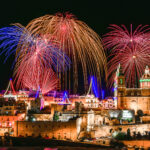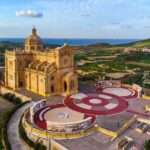Ta Ninu Cave in Gozo Beneath the quiet village of Xaghra in Gozo lies a secret world—one sculpted not by human hands, but by nature itself over thousands of years. Ta Ninu Cave, also known simply as Ninu’s Cave, is a small yet breathtaking underground marvel, tucked away beneath a modest Gozitan home. Though far less known than Gozo’s ancient temples or coastal landmarks, it offers an intimate and unforgettable glimpse into the island’s geological past. This family-owned cave is a true hidden gem. What it lacks in size, it more than makes up for in beauty, charm, and authenticity. For travelers looking to go beyond the guidebooks and discover something unique, Ta’ Ninu’s Cave is a must-visit. Google Location A Discovery by Chance Like many of Gozo’s underground caves, Ta’ Ninu’s Cave was discovered by accident. In 1888, while digging a well under their home, a local family unexpectedly broke through the rock and revealed a small chamber beneath the earth. What they found was astonishing—an underground wonderland of natural limestone formations, sparkling crystal deposits, and coral-like structures sculpted over millennia by mineral-rich water. Rather than sealing it off or commercializing it, the family chose to preserve the cave and open it to visitors, allowing people to experience its natural beauty just as they did. A Personal, Underground Adventure What sets Ta Ninu Cave apart is the personal touch. Visitors are welcomed into the private home above, where a member of the family—usually a friendly and knowledgeable local—leads small tours down a spiral stone staircase into the cave. There’s no crowd, no artificial fanfare—just a quiet descent into the cool, stone-carved chamber below. Once inside, you’re surrounded by a surprising variety of natural formations. The cave’s main chamber is adorned with stalactites, stalagmites, and flowstone curtains, each uniquely shaped by time and dripping mineral water. Some resemble frozen waterfalls, while others look like abstract sculptures crafted by an artist with infinite patience. Despite its compact size, the cave features several striking formations that catch the light and shimmer with calcite crystals. A small lighting system highlights these features without disturbing the cave’s natural feel, creating a serene and almost mystical atmosphere. Ta Ninu Cave vs. Xerri’s Grotto Xaghra is lucky enough to have not one, but two family-run caves—Ta’ Ninu’s Cave and Xerri’s Grotto, which is located just a few minutes away. While both are similar in their origin and setting, each cave offers its own distinct charm. Ninu’s Cave is often praised for its compact yet richly decorated interior, while Xerri’s Grotto is slightly larger and includes a number of extended tunnels. Visitors with the time and interest in geology or photography may want to visit both to fully appreciate the subterranean wonders beneath Xaghra. The Charm of an Authentic Gozitan Experience One of the most rewarding aspects of visiting Ninu’s Cave is how it connects you to the people and traditions of Gozo. Unlike major tourist sites, there’s no sense of rush here. You’re greeted like a CONTINUE READING
Category: Gozo
Xwejni Salt Pans in Gozo
Gozo’s historic Xwejni Salt Pans and see them from the sea on the Waves of Heritage tour—where tradition meets breathtaking coastal views.
Xaghra in Gozo
The charm of Xaghra in Gozo, ancient temples, stunning views, culture, featured on our Waves of Heritage tour with Bluewaves Watersports.
Malta Event Calendar
Malta event heartbeat with kalendarjukulturali.gov.mt – your go-to calendar for theatre, art, music, festivals, and public cultural events.
Zebbug Church in Gozo
Zebbug Church in Gozo and explore Gozo’s heritage with Waves of Heritage, a retro wooden cruise and vintage bus through historic villages
Echoes of the Azure Window in Gozo
The legacy of the Azure Window and Gozo’s stunning coastline on the Waves of Heritage tour with Bluewaves Watersports.
Ggantija Temples in Gozo
Ggantija – The Prehistoric Megalithic Temples of Gozo On the small island of Gozo, just a short ferry ride from Malta, visitors can discover one of the most astonishing archaeological sites in the world: the Ggantija Temples. These ancient structures are not only older than the pyramids of Egypt and Stonehenge but also represent a time when early human communities created sacred spaces with remarkable skill and purpose. Despite their global historical significance, Ggantija remains a lesser-known marvel, offering travelers a rare chance to experience a truly ancient site without the crowds. A Glimpse into Prehistory The Ggantija Temples are part of the UNESCO World Heritage listed Megalithic Temples of Malta and are considered among the earliest free standing stone structures on Earth. Dating back to between 3600 and 3200 BCE, these temples were constructed during the Neolithic period, also known as the Temple Period in Maltese prehistory. The name “Ggantija” comes from the Maltese word ggant, meaning “giant.” According to local legend, the massive stones used to construct the temples were carried and erected by a giantess named Sunsuna, who was said to have built the temple while carrying a child on her shoulder. Although folklore has long attributed the site to supernatural beings, archaeological evidence confirms the builders were part of a highly organized and spiritual society with a sophisticated understanding of architecture, astronomy, and ritual. Location and Layout of Ggantija Located on the outskirts of the village of Xagħra in Gozo, Ggantija is composed of two main temples enclosed within a single boundary wall. This outer wall, made up of colossal limestone blocks, some weighing over 50 tons, is an awe inspiring sight that immediately invokes wonder. How did people without modern machinery move and place these stones with such precision? The exact methods remain a mystery, but archaeologists suggest the use of spherical stone rollers and levers. Each of the temples features a clover leaf layout known as a trefoil design, consisting of semicircular apses branching off from a central corridor. This design is characteristic of Maltese temple architecture and appears across other prehistoric sites on the islands. The inner sanctuaries were likely used for ceremonial and religious purposes, possibly involving fertility rituals and offerings to deities. Spiritual Significance of the Ggantija Temples While Gozo is also known for its many beautiful churches, such as the Basilica of Ta’ Pinu, the Ggantija Temples offer a much older glimpse into the island’s sacred history. Archaeological findings such as altars, hearths, and animal bones suggest that Ggantija was a site of communal worship and ritual. The temples may have been dedicated to a mother goddess or fertility cult, as implied by figurines and statues unearthed in the area. The emphasis on round, voluminous forms in the statues aligns with fertility symbolism found in other ancient cultures. The orientation of the temples also holds astronomical significance. The southern temple’s main entrance is aligned with the solstices, suggesting that the builders had an understanding of celestial patterns, possibly linking their CONTINUE READING
Feasts of Malta
The Vibrant Feasts of Malta: A Celebration of Faith, Tradition, and Culture Malta, a small island nation in the heart of the Mediterranean, is known for its rich history, stunning landscapes, and warm, welcoming people. However, one of the most captivating aspects of Maltese culture is the island’s deep-rooted tradition of religious feasts. These lively celebrations, which take place throughout the year, are a blend of spirituality, community, and festivity, drawing locals and tourists alike to experience the unique atmosphere of Malta’s vibrant villages. Feasts, or “festas,” are an integral part of Maltese life. While they are primarily religious in nature, honoring patron saints and their respective churches, they also serve as important social events, offering a sense of unity, joy, and pride. Visitors to Malta can expect to see colorful processions, hear bands playing traditional marches, and witness spectacular fireworks displays — all while enjoying local food and drinks in a festive atmosphere. The History of Maltese Feasts The tradition of feasts in Malta dates back centuries, influenced by the island’s deep Catholic roots and its long history of occupation by various powers, including the Phoenicians, Romans, Arabs, Normans, and the Order of St. John (the Knights Hospitaller). Under the Knights, Malta became a center of Christian devotion and military might, and religious observances were a central part of daily life. This influence still shapes the way feasts are celebrated today. The feasts are usually dedicated to the patron saints of towns and villages across Malta. It is common for every town or village to have its own annual feast, often held on the feast day of its patron saint. The festivities typically start on the Saturday before the actual feast day and continue through to Sunday, sometimes even lasting for a whole week. During this time, the local church is adorned with colorful decorations, and the streets are filled with lights, banners, and flowers. What to Expect at a Maltese Feast A Maltese feast is a multi-sensory experience that combines religious observance with lively festivities. Here are some of the key elements that you can expect when attending one of these vibrant events: The Procession: The heart of any feast is the procession, which is typically held on the feast day itself. A statue or image of the patron saint is paraded through the streets, often accompanied by prayers, hymns, and incense. The procession is a deeply religious event, with many locals participating by walking alongside the statue, carrying candles or offering prayers. The procession is often accompanied by a band, playing traditional marches, which add to the festive atmosphere. Fireworks Displays: One of the most spectacular aspects of Maltese feasts is the fireworks. These displays are often grand and impressive, lighting up the night sky in vibrant colors. The fireworks are traditionally fired from the church or a nearby open space, and each village competes with others to put on the best display. The history of fireworks in Malta dates back to the 18th century, and they CONTINUE READING
Churches of Gozo
Churches of Gozo, Malta’s Spiritual Jewel The island of Gozo is a treasure trove of spiritual heritage, with churches that speak to centuries of devotion, artistry, and architectural grandeur. While often overshadowed by its larger sister island, Malta, Gozo offers an intimate and authentic experience for travelers seeking both cultural immersion and sacred beauty. Gozo, though just 67 square kilometers in size, is home to over 40 churches, a remarkable number considering its modest population. Each of these churches, from majestic cathedrals to humble chapels, tells a story of faith, tradition, and the enduring strength of the island’s Catholic roots. The Cathedral of the Assumption, Victoria, Gozo No visit to Gozo is complete without exploring the Churches of Gozo. One famous place in Gozo is Victoria, the island’s capital, and its crown jewel, the Cathedral of the Assumption. Nestled within the imposing Cittadella, the cathedral stands as a testament to Baroque elegance and spiritual devotion. Built in the late 17th century on the site of an earlier church, the cathedral is dedicated to the Assumption of the Virgin Mary. Its most remarkable feature is an illusory dome, a masterful trompe-l’œil painting by Italian artist Antonio Manuele that gives the impression of a grand dome where there is none. Inside, the cathedral offers serene beauty, from its gilded altar to the intricate marble floor tombstones that echo the voices of centuries past. The cathedral’s construction was strongly supported by the Order of St. John, the Knights Hospitaller, who were central to the governance of Malta during this period. The Order’s influence in Gozo, and Malta at large, can still be felt in the grandeur of the churches and fortifications built during their time. The panoramic views from the Cittadella’s ramparts are a reward in themselves, rolling hills, limestone villages, and a skyline peppered with church domes as far as the eye can see. Ta’ Pinu Basilica – A Place of Pilgrimage and Miracles Perhaps the most iconic and revered church on the island is the Basilica of the National Shrine of the Blessed Virgin of Ta’ Pinu. Located near Għarb, this Roman Catholic basilica is considered a sacred site not just for Gozitans but for all Maltese. The church gained prominence after a local woman claimed to hear the voice of the Virgin Mary in the 1880s. Since then, Ta’ Pinu has become a pilgrimage site associated with miraculous healings and answered prayers. The current basilica was completed in the 1930s and consecrated in 1932. The architecture is neo-Romanesque, with a honey-colored stone façade that glows in the Mediterranean sun. The interior is peaceful and awe-inspiring, adorned with mosaics, marble, and ex-voto offerings, testimonials to faith and gratitude. The surrounding countryside also features a series of outdoor mosaics and stations of the cross, ideal for quiet reflection. Xewkija Rotunda: Gozo’s Architectural Wonder In the village of Xewkija stands one of the most remarkable churches in Gozo, the Rotunda of St. John the Baptist, commonly referred to as the Xewkija Rotunda. It CONTINUE READING
Sharks in Malta
Sharks in Malta: A Rare and Beautiful Encounter with Nature At Bluewaves Watersports, we’re passionate about Malta’s stunning marine life. Our crystal-clear Mediterranean waters are home to an incredible array of sea creatures, from playful dolphins to colorful fish. One fascinating but often misunderstood ocean dweller very rarely makes an appearance in our waters. The shark. Before your imagination runs wild, let us reassure you, Malta is not known for shark activity, especially near the coast. In fact, shark sightings here are very rare. But when one does appear, as happened recently in Sliema, it’s a wonderful reminder of how rich and healthy our marine ecosystem truly is. A Peaceful Visitor in Sliema – 09/05/2025 On May 9th, 2025, beachgoers and walkers along the Sliema coast witnessed a special and rare sight, a small shark was seen calmly swimming close to shore. The video quickly made rounds on social media, with onlookers expressing surprise and awe at the peaceful presence of this ocean visitor. Marine experts believe the shark was likely a blue shark (Prionace glauca), a sleek, deep-sea species known for its striking blue coloration and gentle nature. These sharks live far offshore and are not typically found near beaches. Sightings near the coast are exceptionally rare, and this one came with calm seas and perfect visibility, ideal conditions for such an encounter. The shark posed no threat to swimmers, and officials confirmed there was no danger or need for alarm. In fact, it was a positive sign that our local waters remain clean and biodiverse. Sharks are essential indicators of a healthy ocean, and seeing one in Malta is a rare and special moment to appreciate. Sharks in Malta: The Facts Malta’s surrounding waters are home to over 30 species of sharks, but most are small, non-aggressive, and live in deep waters far from shore. The reality is that you are extremely unlikely to ever see a shark while swimming, snorkeling, or enjoying water activities here. In fact, shark-related incidents in Malta are virtually unheard of. Sharks do not hunt humans, their diet consists mainly of fish and squid, and they are naturally wary of people. Interestingly, the waters near Filfla, an uninhabited islet south of Malta, are one of the island’s richest marine ecosystems and an occasional habitat for larger marine species, including some types of sharks. However, this area is far from regular swimming zones and is a protected nature reserve, ensuring minimal interaction with humans. At Bluewaves Watersports, safety is our top priority. In all our years operating here at Bluewaves Watersports, we’ve never had any kind of shark-related issue. The sighting on 09/05/2025 in Sliema was not a warning, it was a rare and beautiful reminder of nature’s balance. Sharks: Guardians of the Sea Sharks are a vital part of the marine ecosystem. As apex predators, they help maintain the balance of other marine life, keeping populations in check and supporting the overall health of coral reefs and fish stocks. Despite their important role in CONTINUE READING












